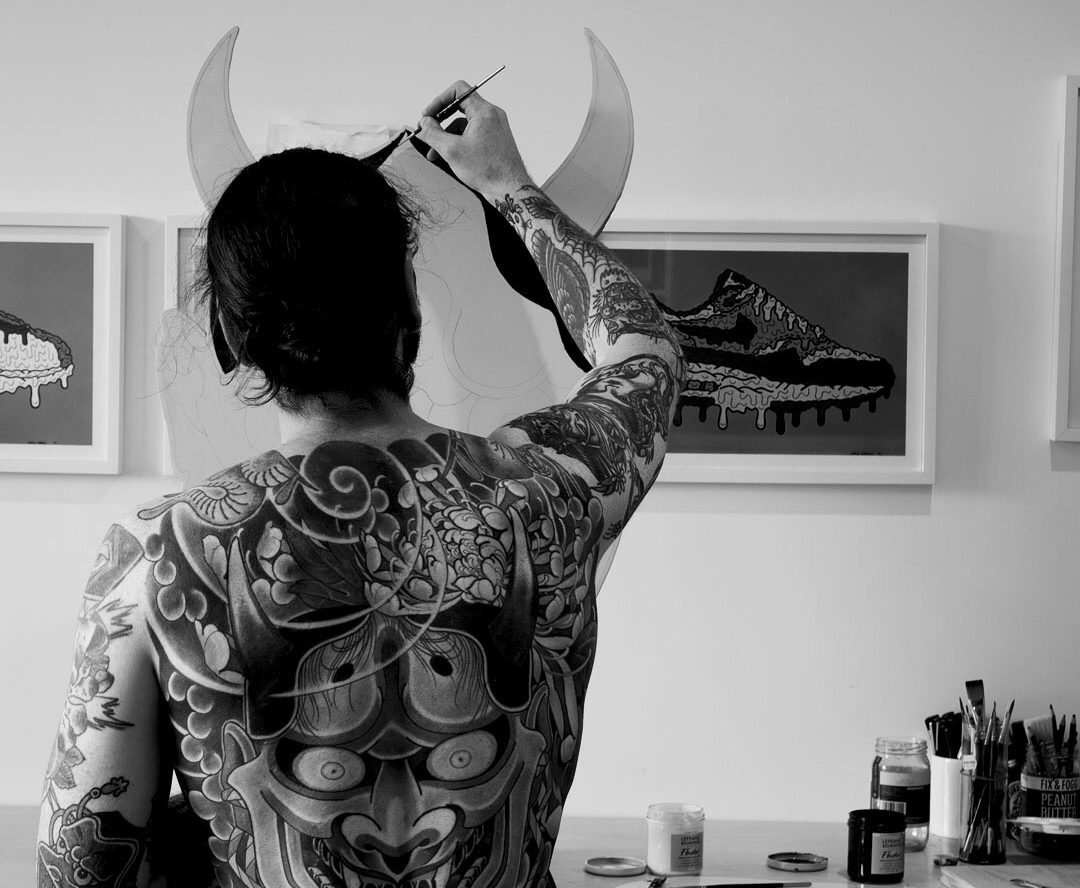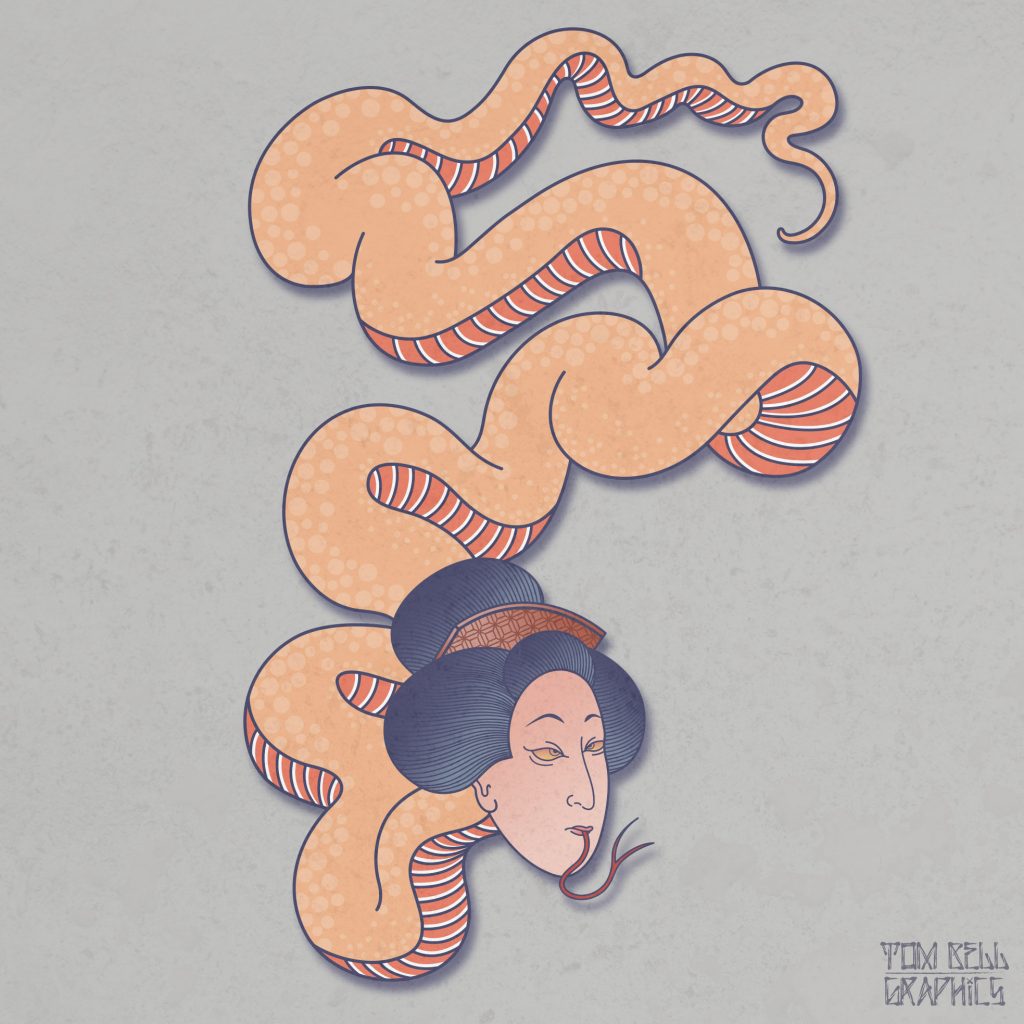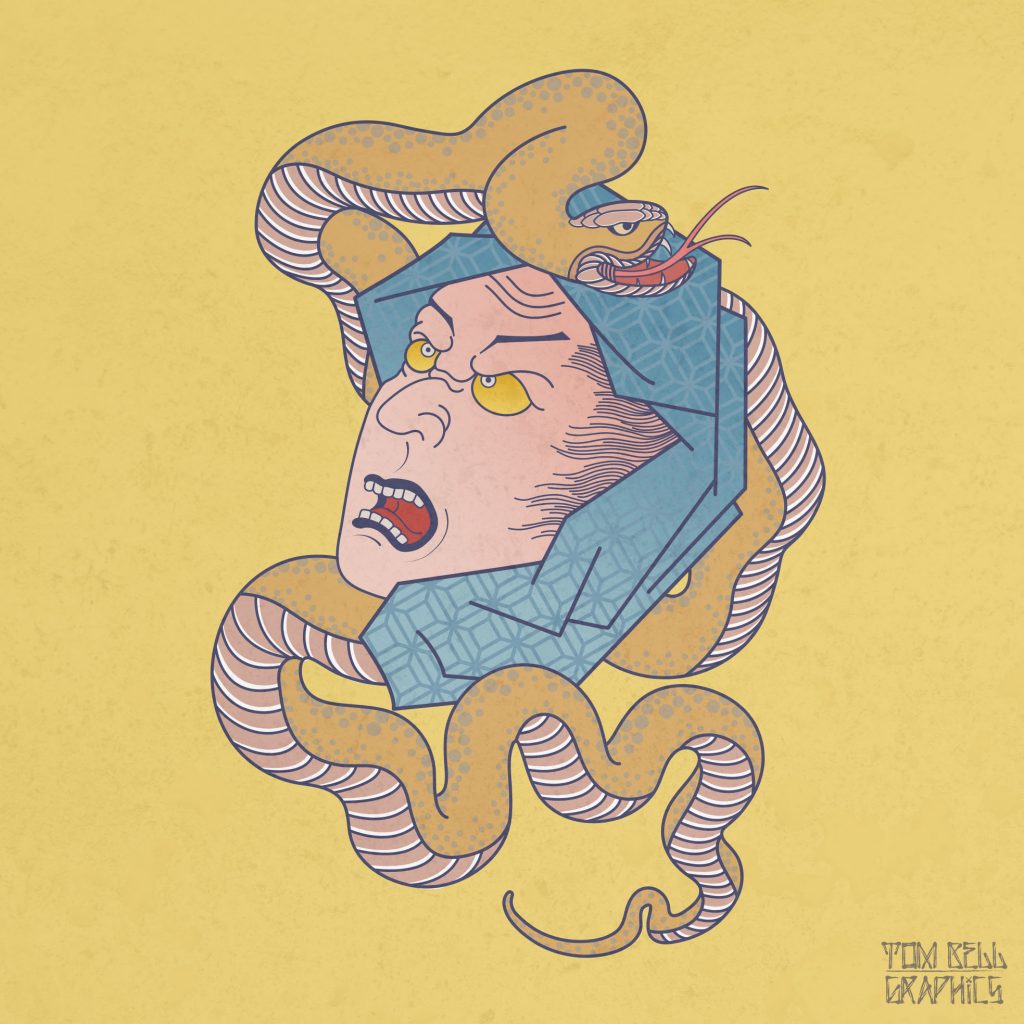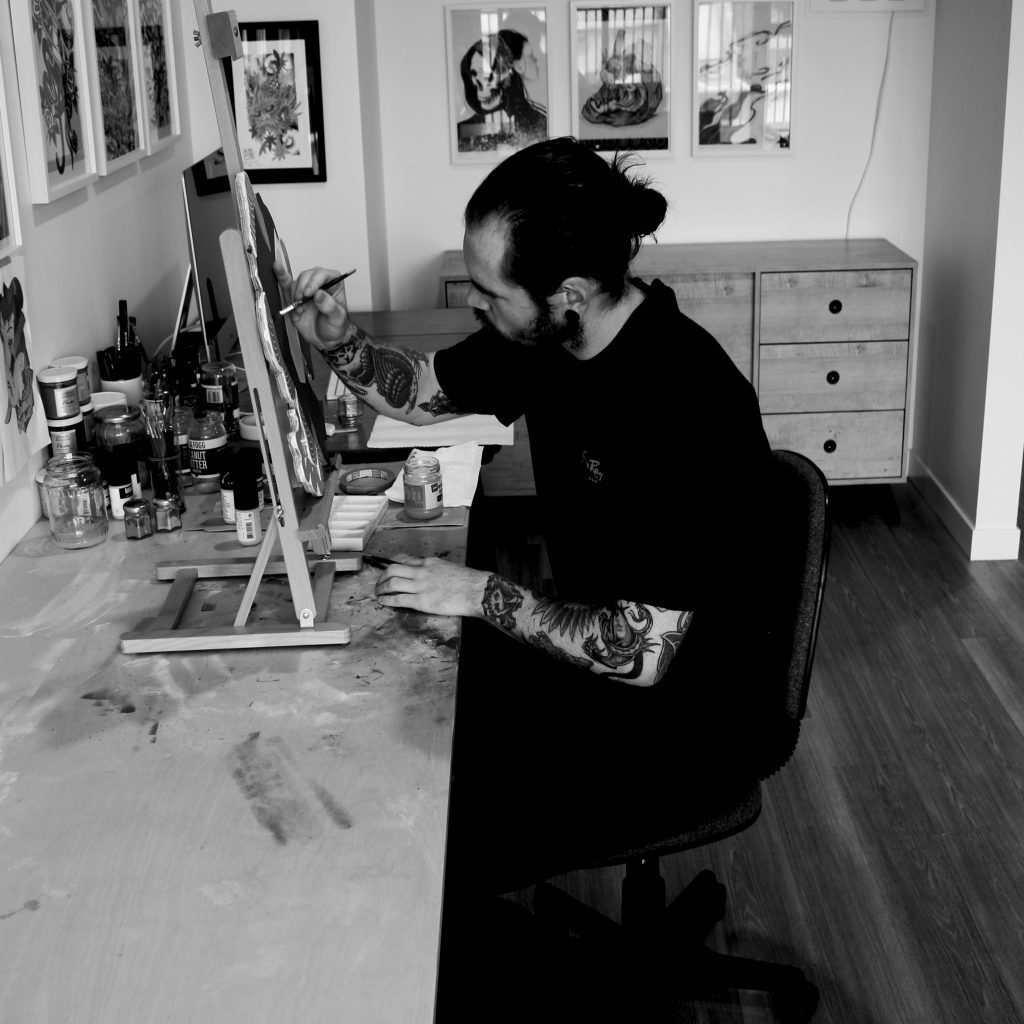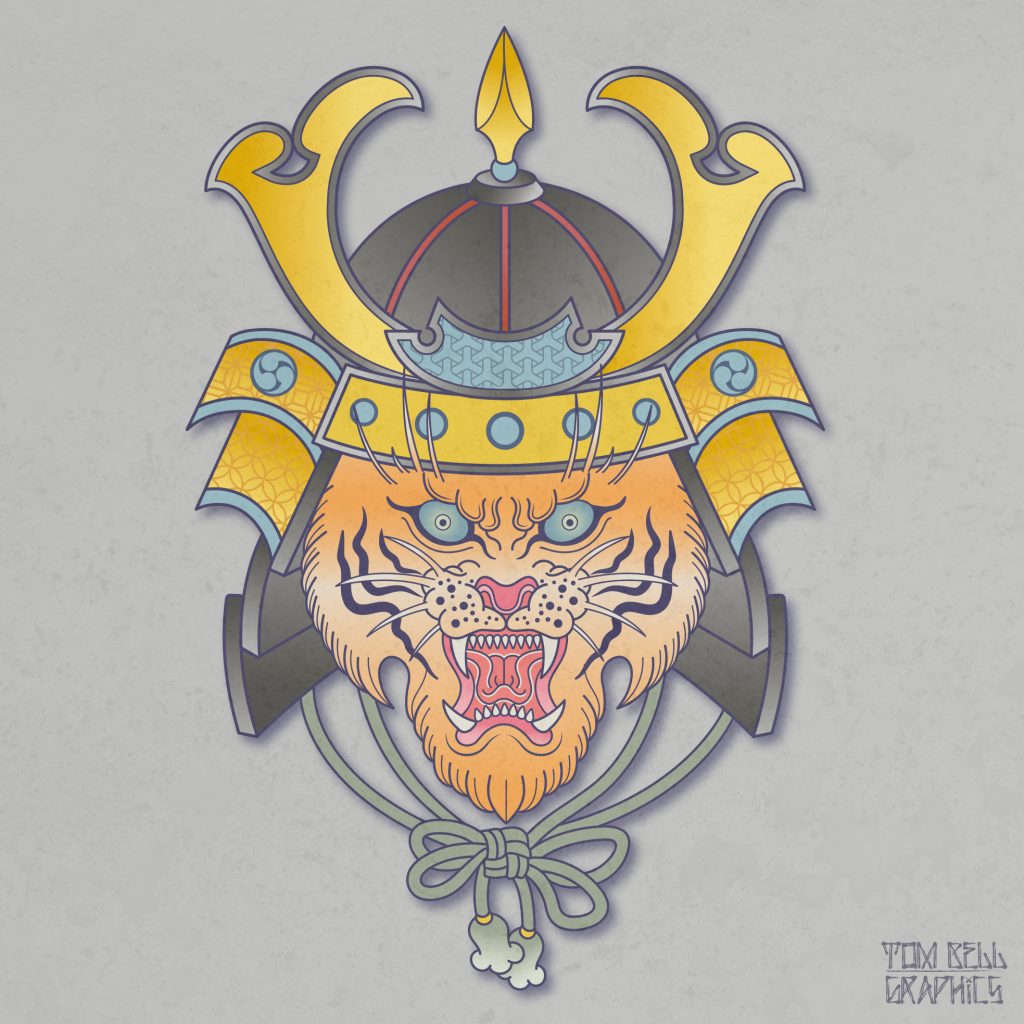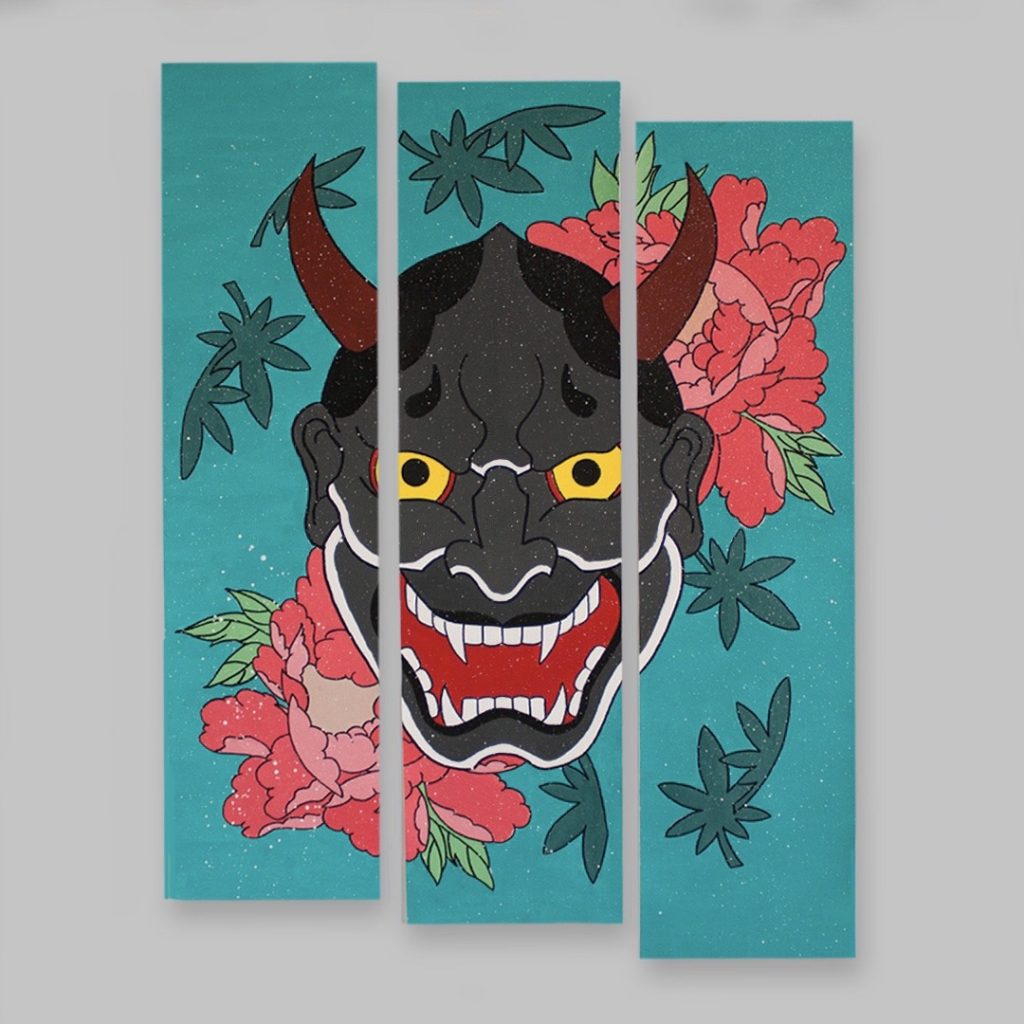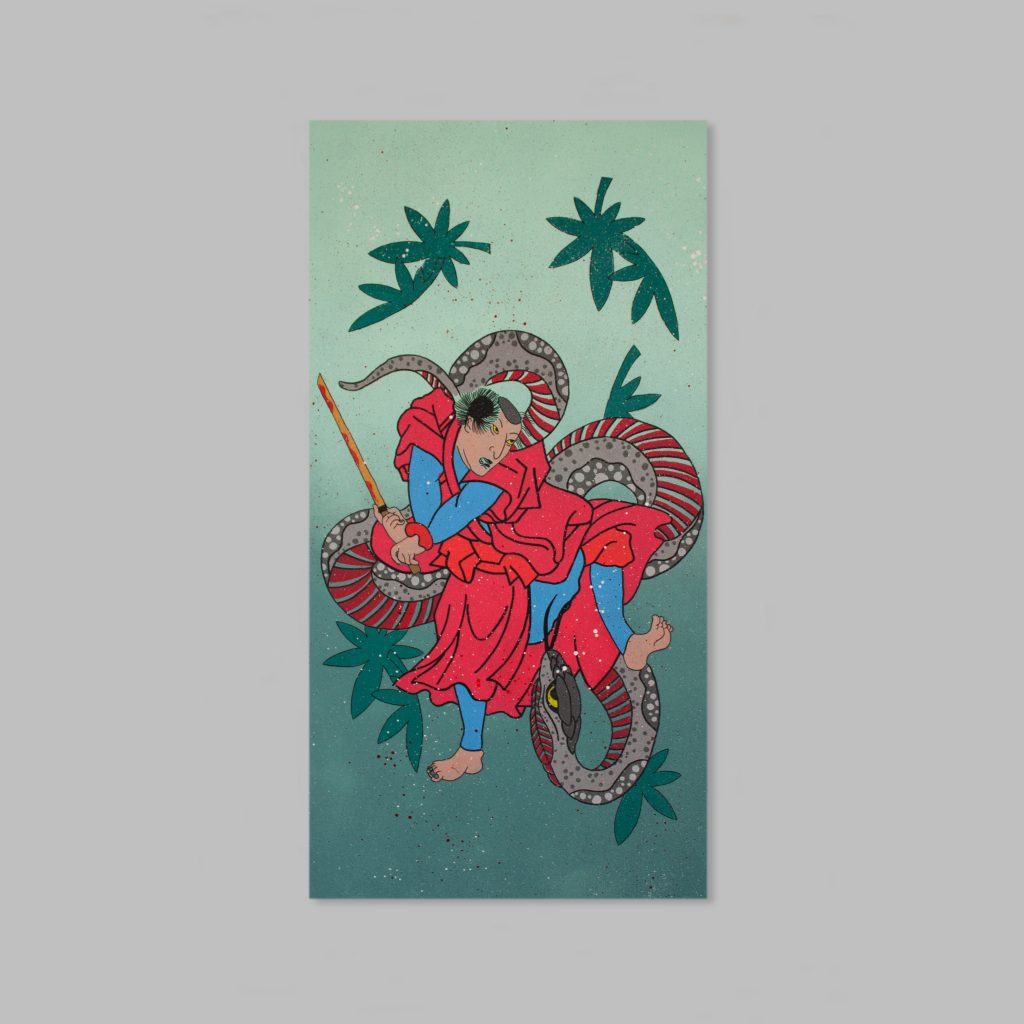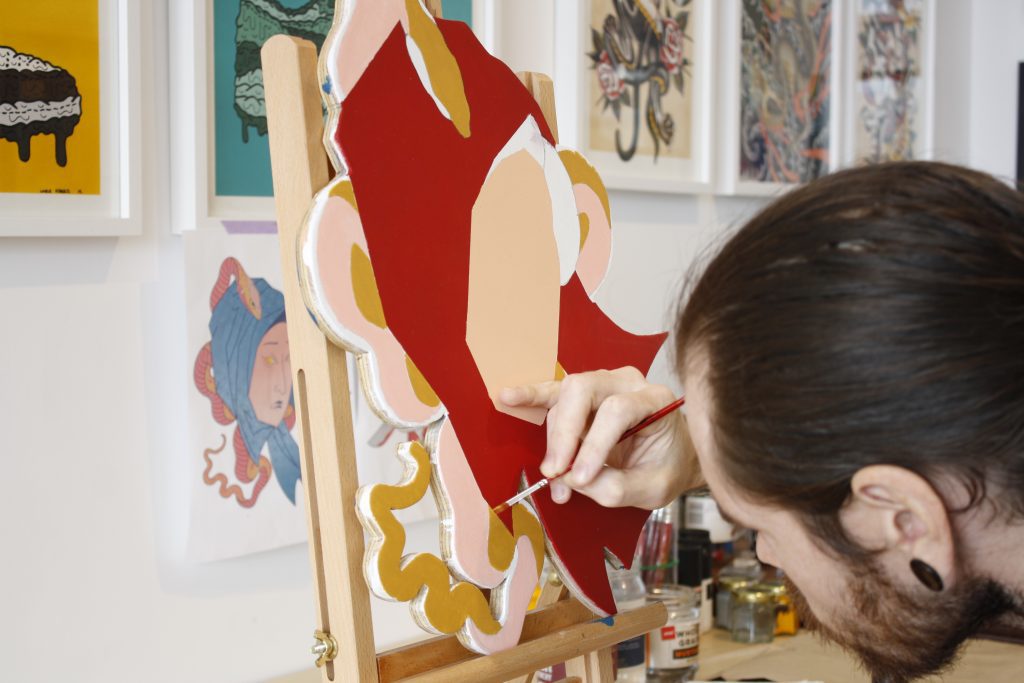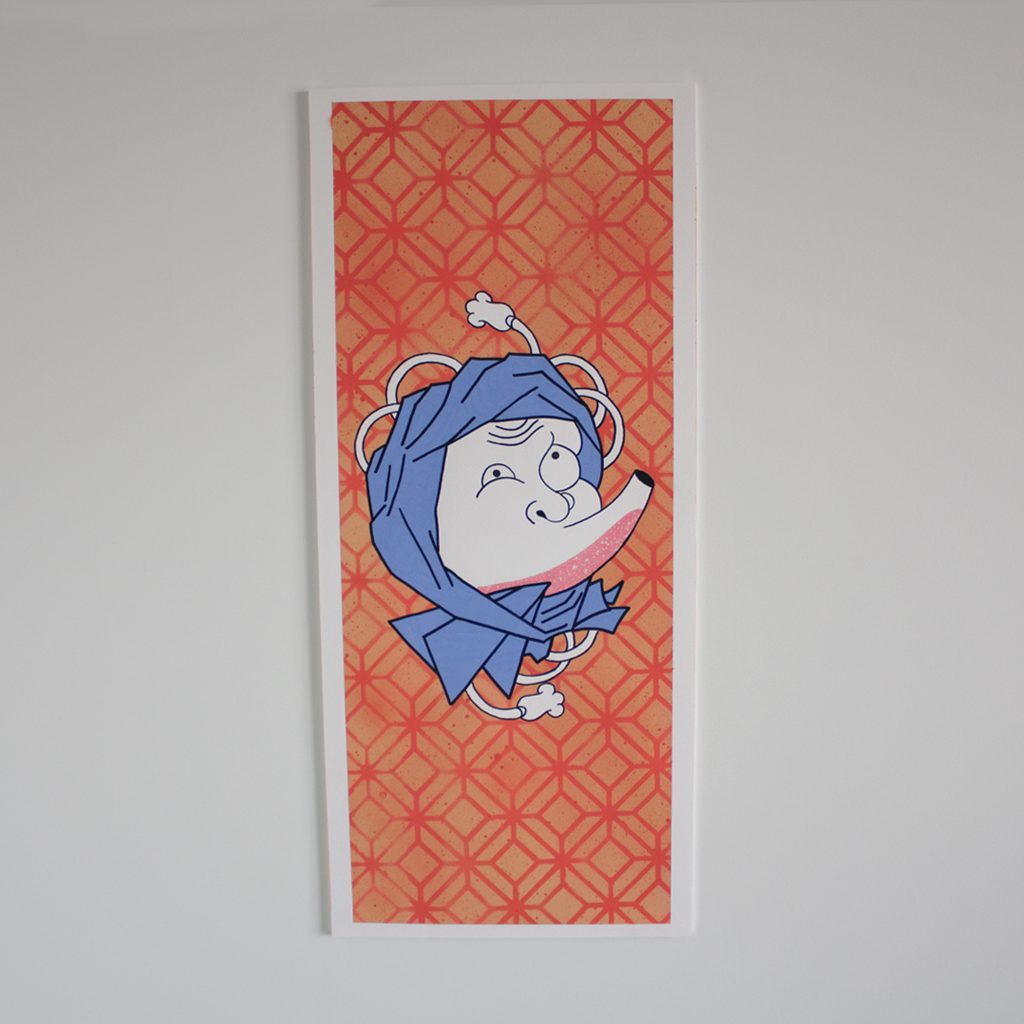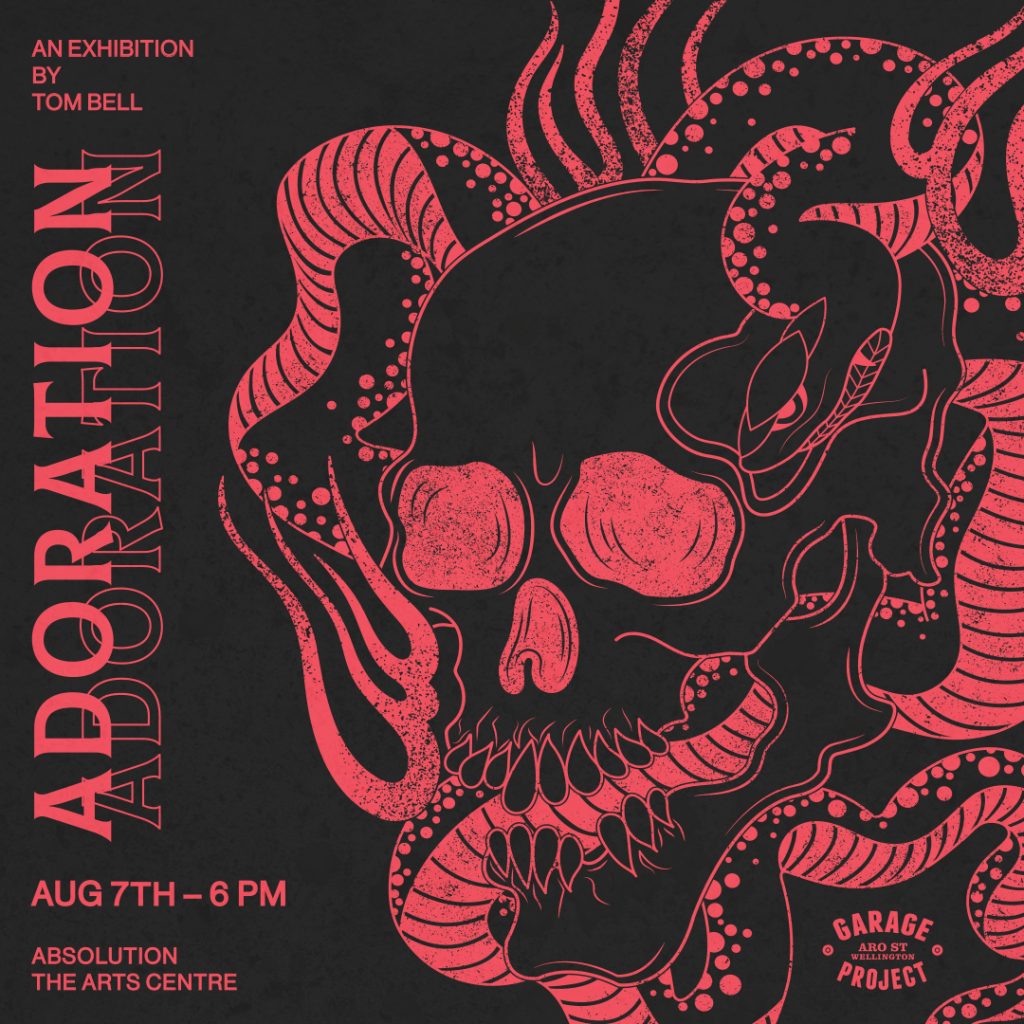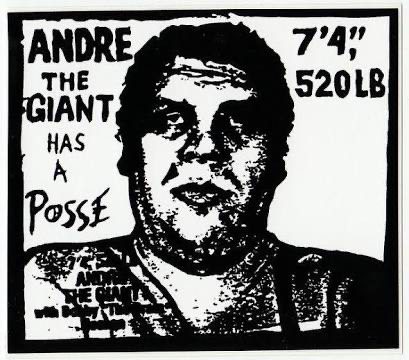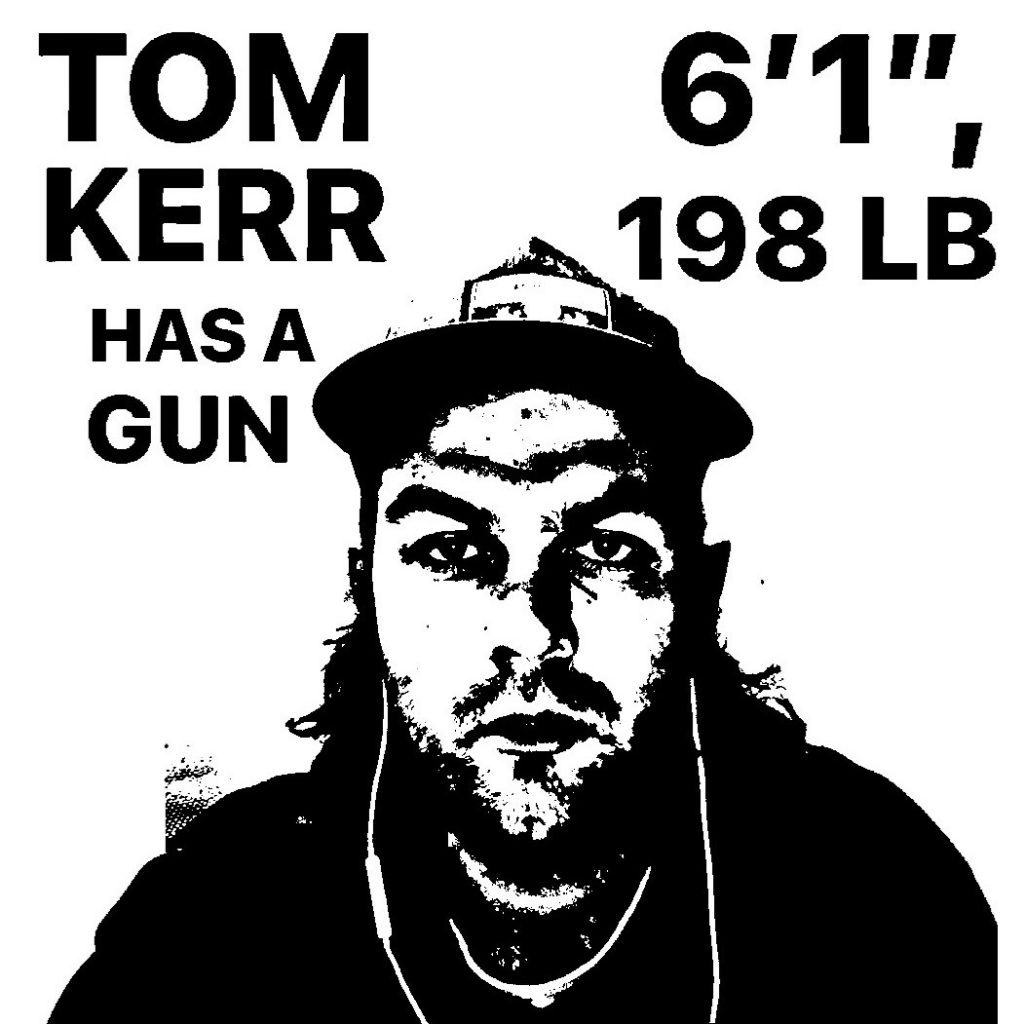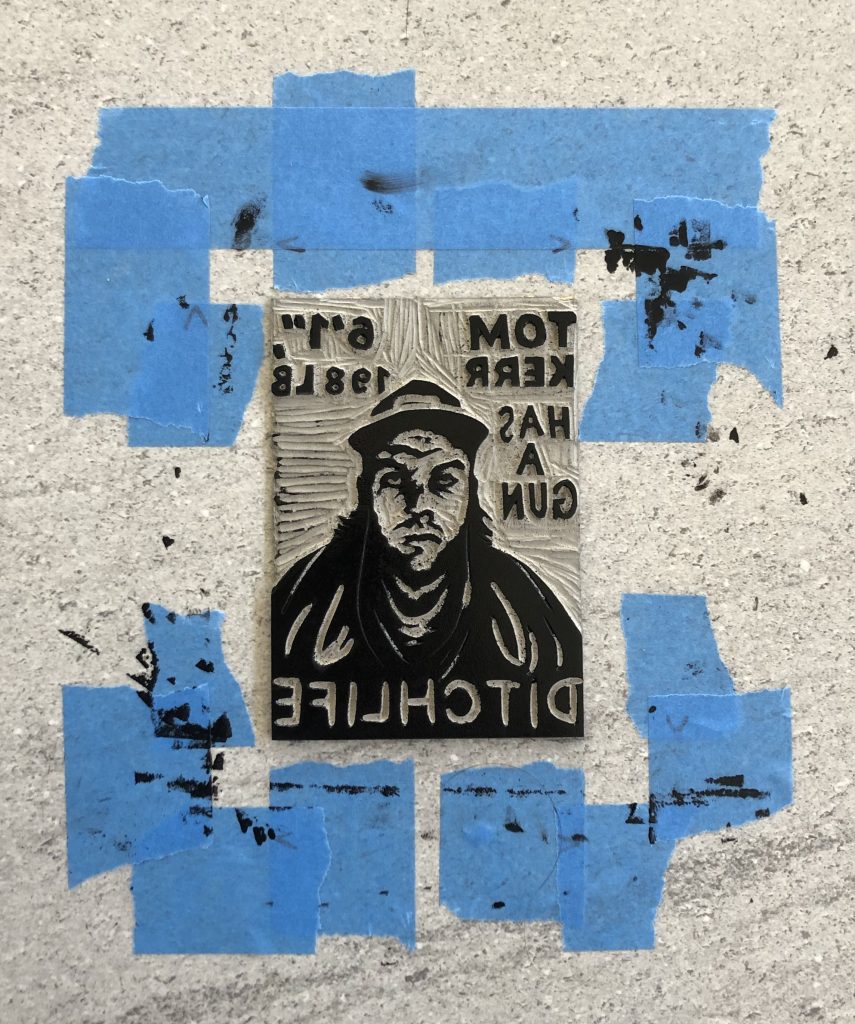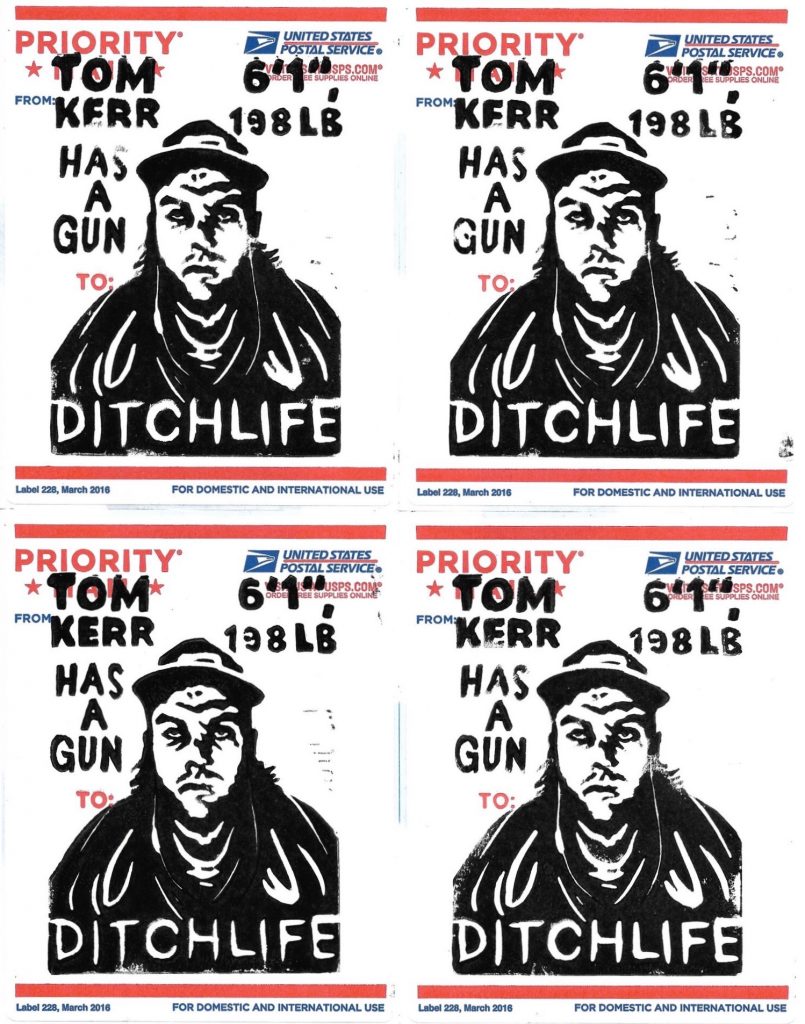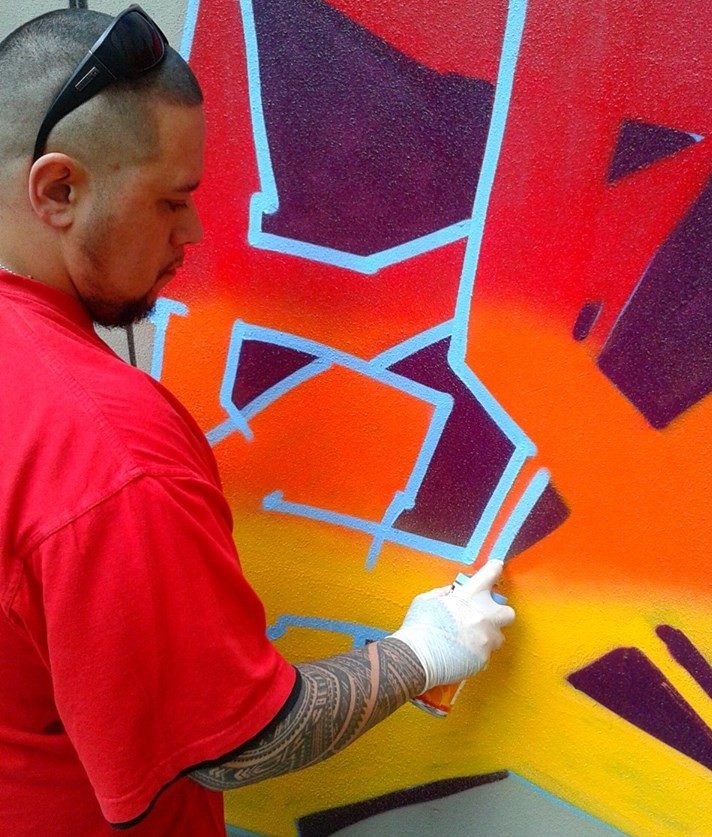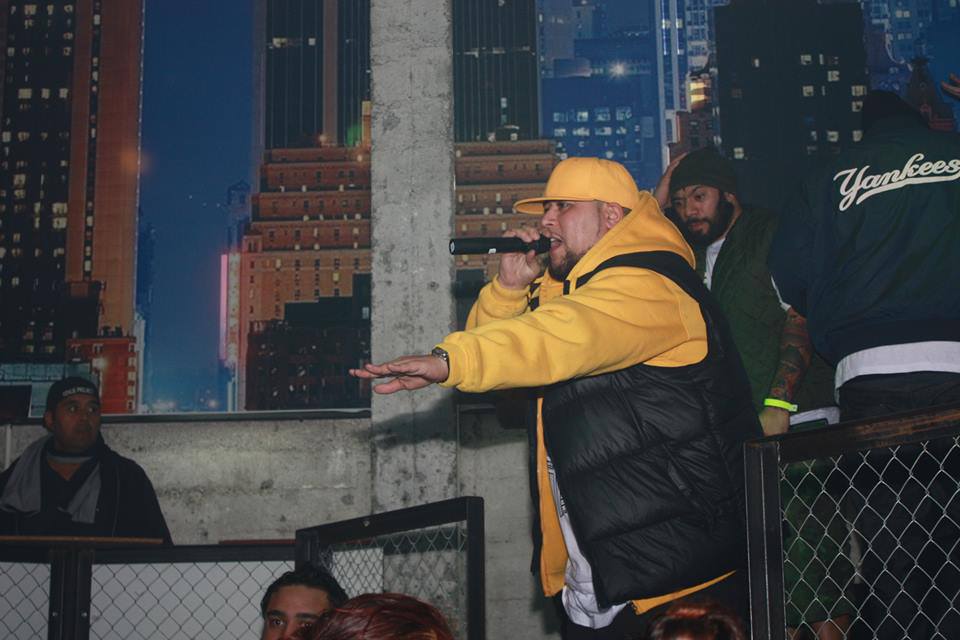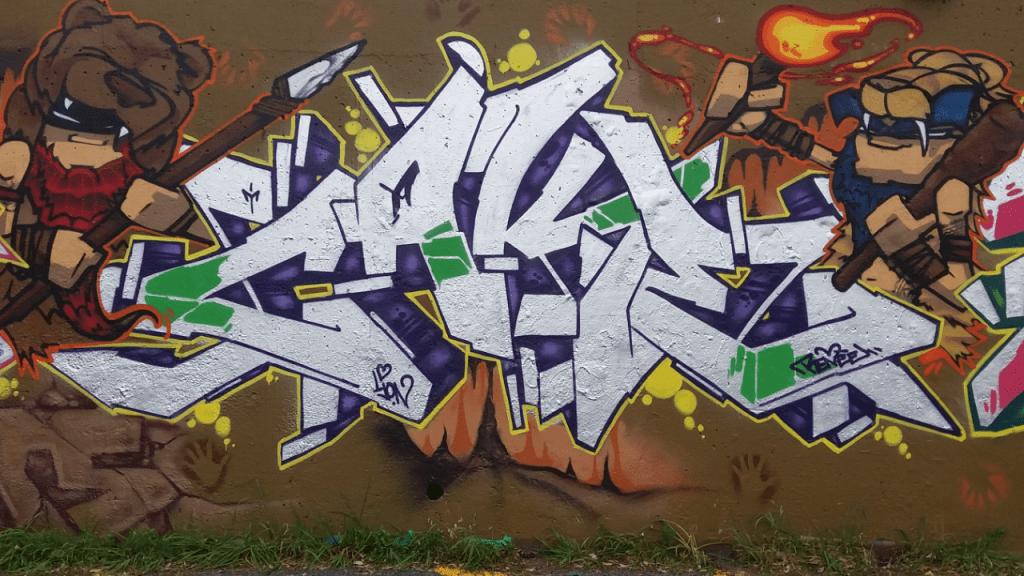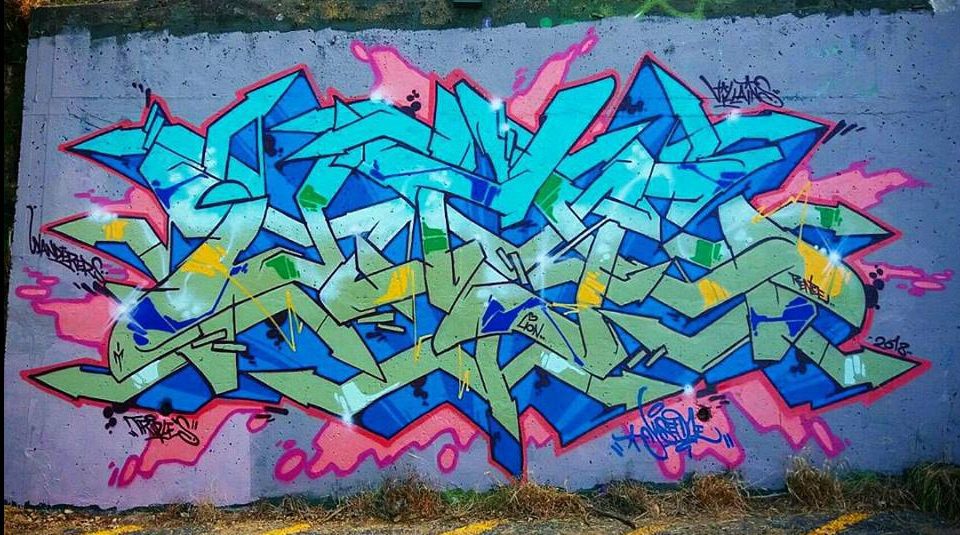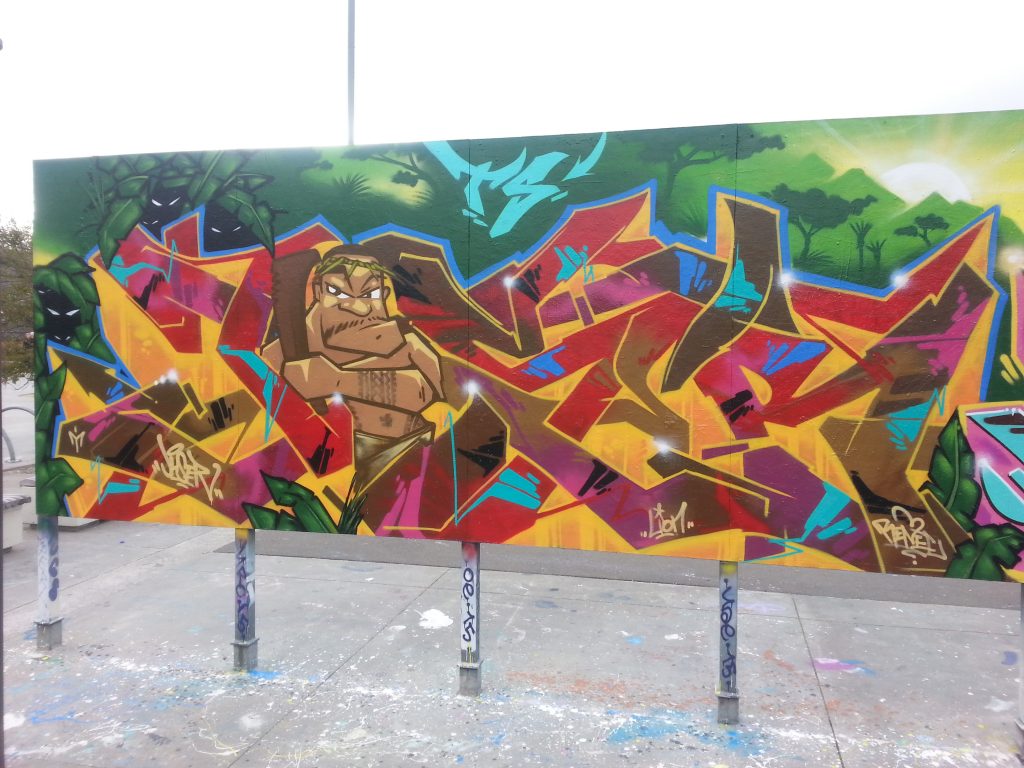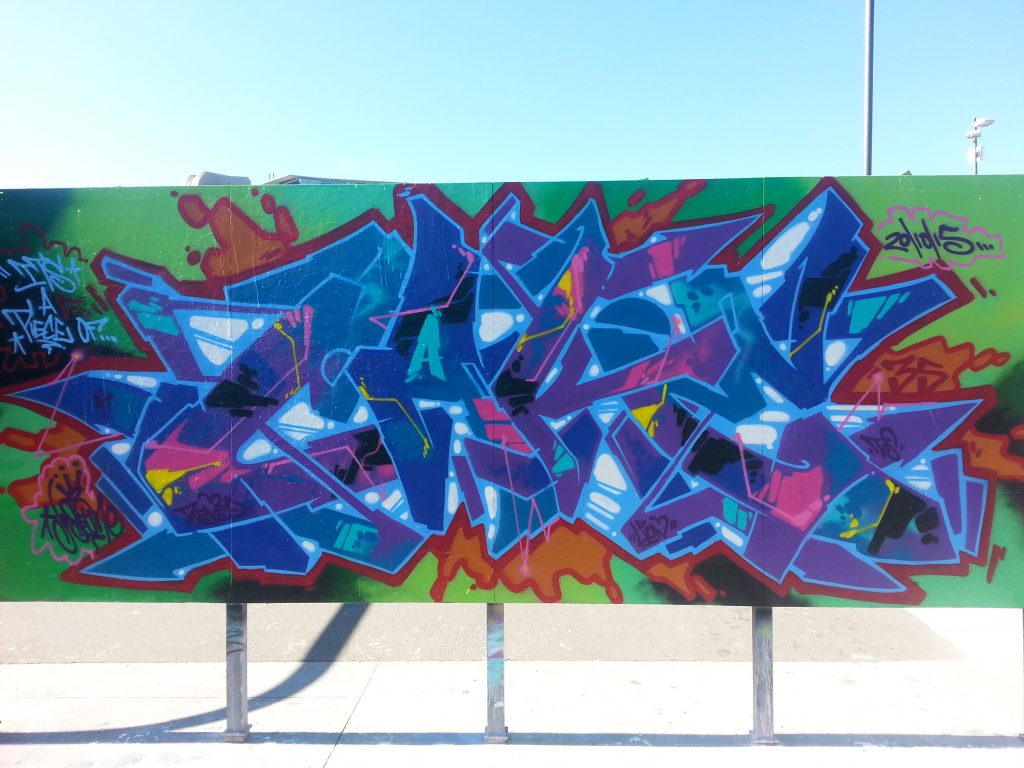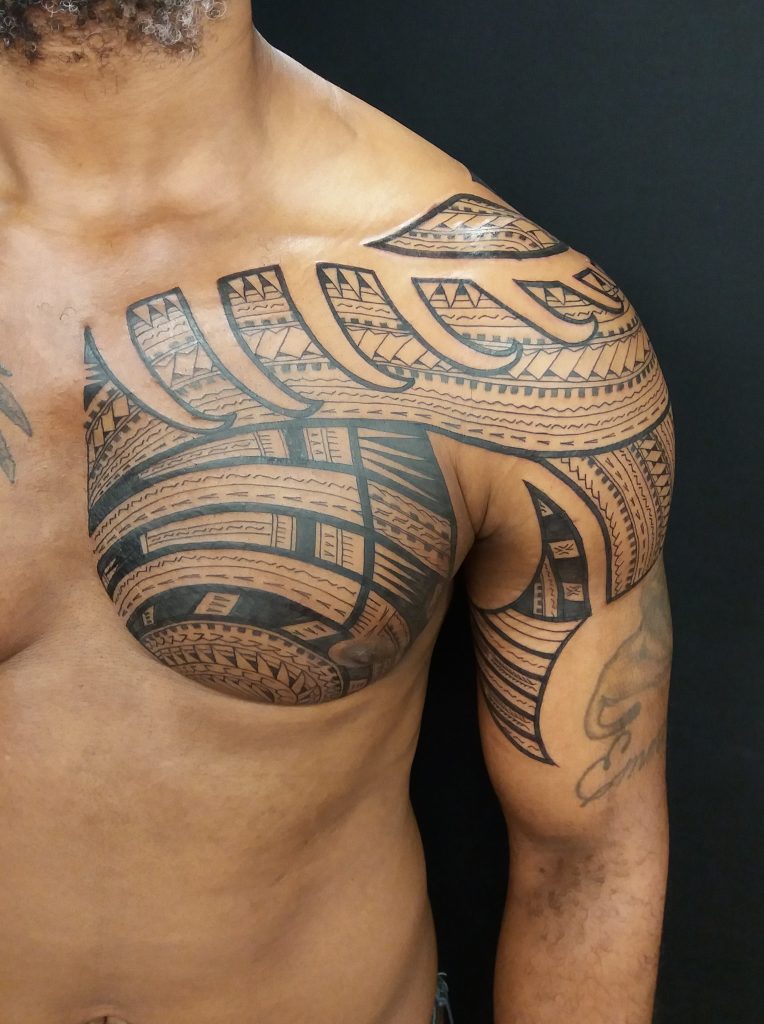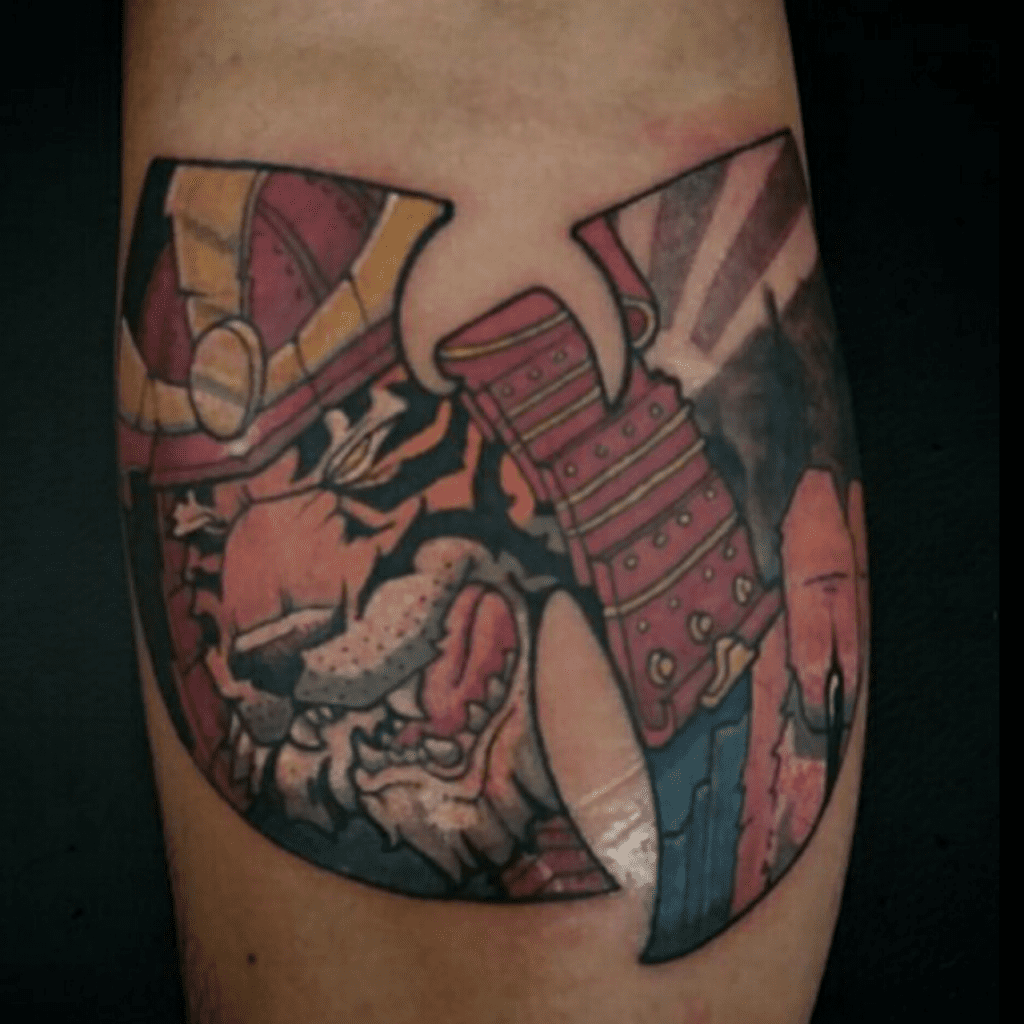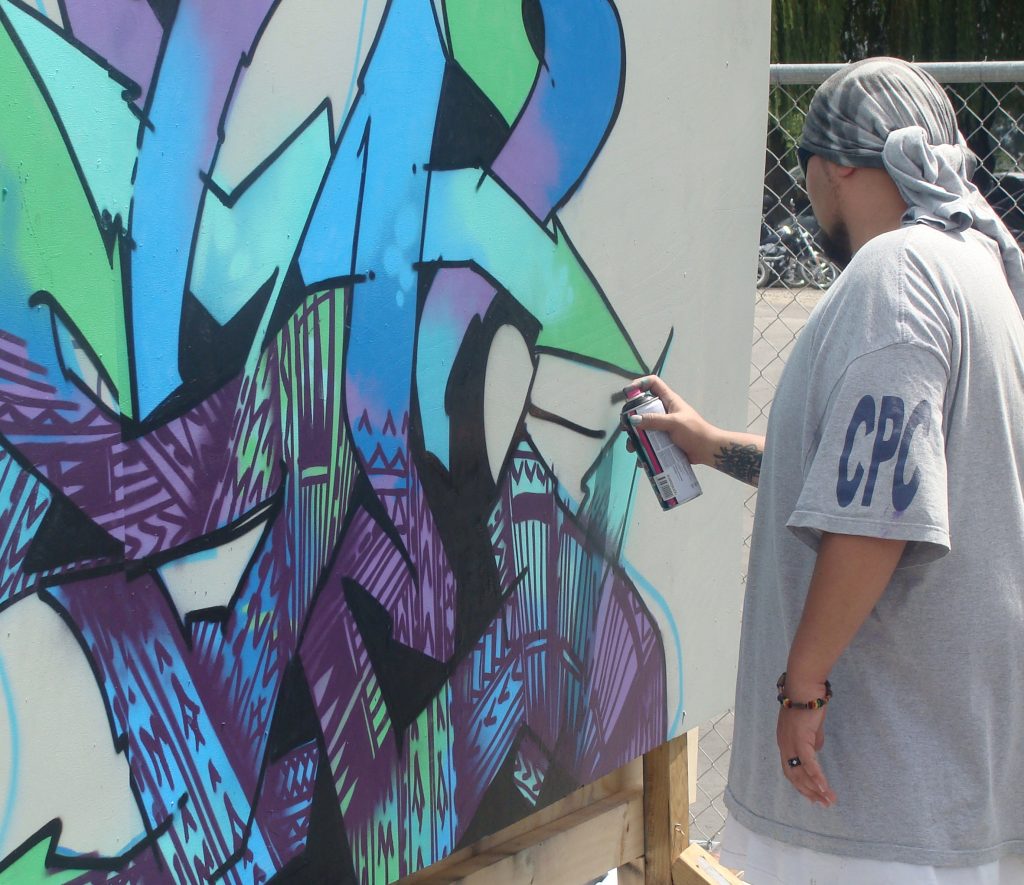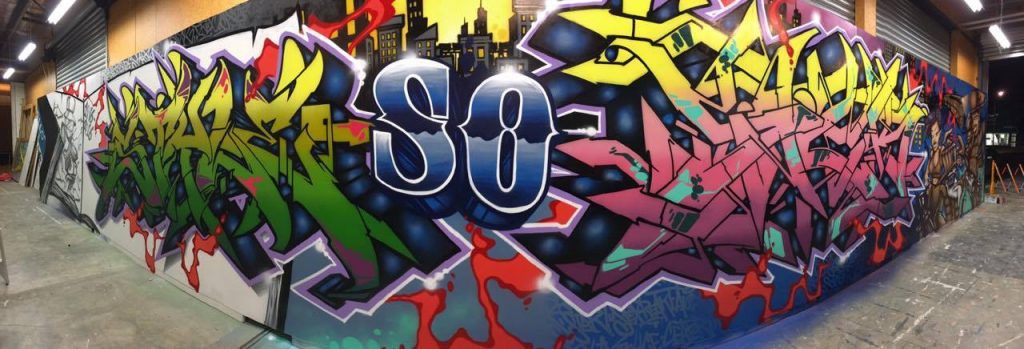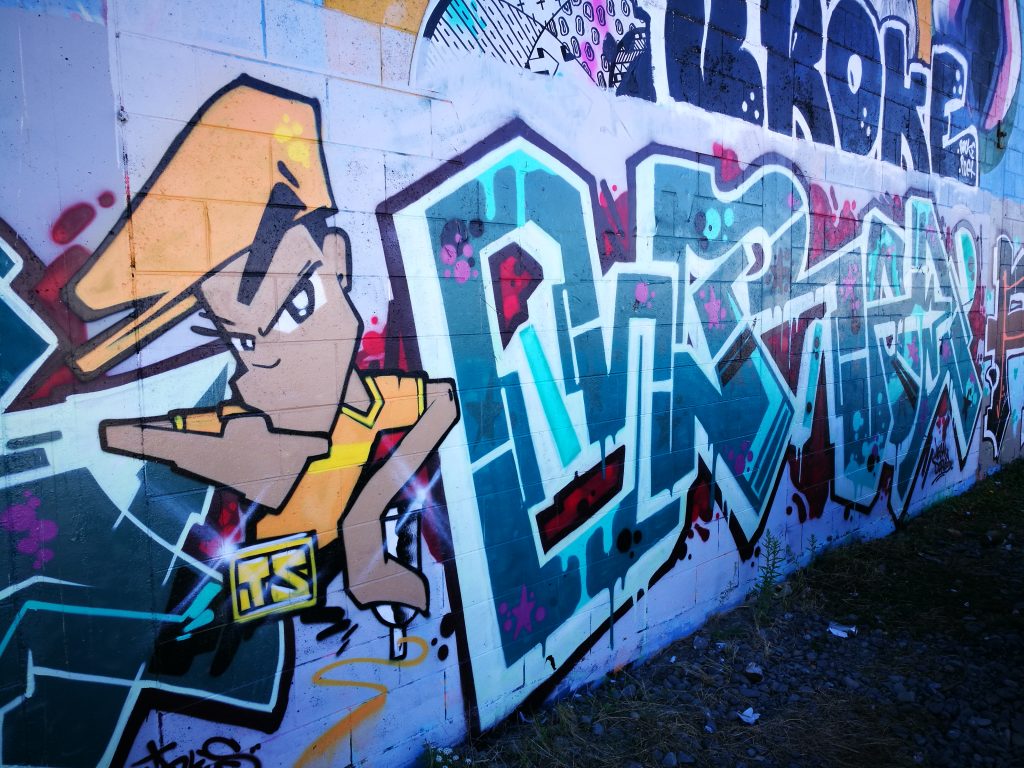I remember seeing Tom Kerr’s tattoo flash drawings illustrating lines from Bruce Springsteen’s iconic 1982 album Nebraska on Instagram around two years ago. As a long time fan of the musician, I was an immediate intrigued. The album, famously recorded in Springsteen’s bedroom on a four track recorder, stands as one of the New Jersey native’s most celebrated works, devoid of the stadium rock scale and instead focussed on Springsteen’s intimate Americana story telling. I reached out to Tom at the time and he told me of his plan to draw imagery for every song, I was excited to see what would come from the project. It may have taken some time, but finally the suite is ready for exhibition as a complete body of work. As you can imagine, I was excited to sit down with Tom and we sermonised about Springsteen, Nebraska and the process of making these works…

I have always found, depending on prevailing tastes, that it can sometimes be hard to admit that you are a Springsteen fan, you never know response you are going to get! For some people, it’s still the flannel shirt and Born in the USA, but there is, of course, this whole other side to Springsteen. How did you kind of come across his music?
My dad is a huge fan, so growing up, Springsteen classics were always playing, especially Born in the USA and Born to Run and stuff, but I think getting older and being a young adult, I just resented Springsteen and thought for so long it was just dad music. Then my really good friend Dan, who probably has the best taste in punk music I know, was like, have you listened to Nebraska? I was like, nah, I don’t really rate any of Springsteen’s music, it’s all dad rock or whatever. I think he said something like, forget everything you know about Springsteen before you listen to this album, it’s not a big band, there are no saxophone solos or type of shit. I was really into lo-fi music, recorded songs, and I got more and more into that and through that I went back to Springsteen’s wider catalogue and listened to Born to Run and that’s when I fell in love with all the classics. You get to an age when you realise the music your parents loved is good. As a kid, you push so hard to be like, I don’t want to like the music my parents liked, I’ve got better taste than they do. But then you grow up and realize that Elton John and Springsteen and Cat Stevens, and all those dudes are flawless musicians…
The idea of Springsteen being ‘dad rock’ was so strongly entrenched from his mega star status in the 80s, but I was always more into his early, kind of romantic street poet aesthetic, the storytelling, the Magic Rat and stuff like that, and then Darkness on the Edge of Town, The River and eventually Nebraska continue that storytelling vein in a darker tone. Born to Run is about escaping, but those later albums are about being trapped, or what happens when you don’t get out, and I think as you get older, there’s something about that idea…
With Nebraska, the songs are so well done, you listen to Johnny 99 or Highway Patrolman and they go for three minutes and you know everyone in the song, you know about their dreams, their aspirations. The song ends and you are like, how have you painted such a picture with like three chords and just like talking about these guys? He tells us how characters went to war, how the farm didn’t work, about having a brother who is a loose cannon and shit, I couldn’t tell someone that much information in just three minutes…
They are short, yet they are almost cinematic in scope and vision. The other interesting thing is Springsteen’s influence on the New Jersey punk scene, right? The Dropkick Murphys, The Gaslight Anthem, he’s had this interesting standing where the broader public have this perception, but the people in the know have a different understanding…
I think it comes from digging a little deeper. Born in the USA was his commercial success, it was in the 80s and there was so much marketing when they made that album, they made him shave and go to the gym to look like a working-class farm boy or whatever. But in reality, if you look at photos from Greetings from Asbury Park, he’s wearing a beanie, he has long hair and is wearing bell bottoms and shit, and he’s the complete opposite of what most people think of Springsteen…
The ripped arms, the sleeveless flannel shirt, the headband, but then you go back to that earlier ‘Skeeter’ persona, the leather jacket and the oversized beanie, the scraggly beard, hanging around in Asbury Park, playing bars like The Stone Pony…
The E Street Shuffle kind of stuff…
Born in the USA is interesting though, it is really misunderstood, it is actually an album that’s way darker than everyone perceives, there is actually a kinship with Nebraska…
Nebraska was all demos. I think they did The River and they toured it and then Bruce wanted to break off from the E Street Band and become a solo musician or he wanted to break off from the concept of what The E Street Band were doing, so he recorded these demos and when he took them to the label, they were like, this isn’t happening, so he went back in the studio and did Born in the USA. In the Born in the USA tours they do live versions of Johnny 99 and a few more of the demos that were in Nebraska actually ended up on Born in the USA, like Working on the Highway. I think they tried them all as full band songs and half of them just flopped…
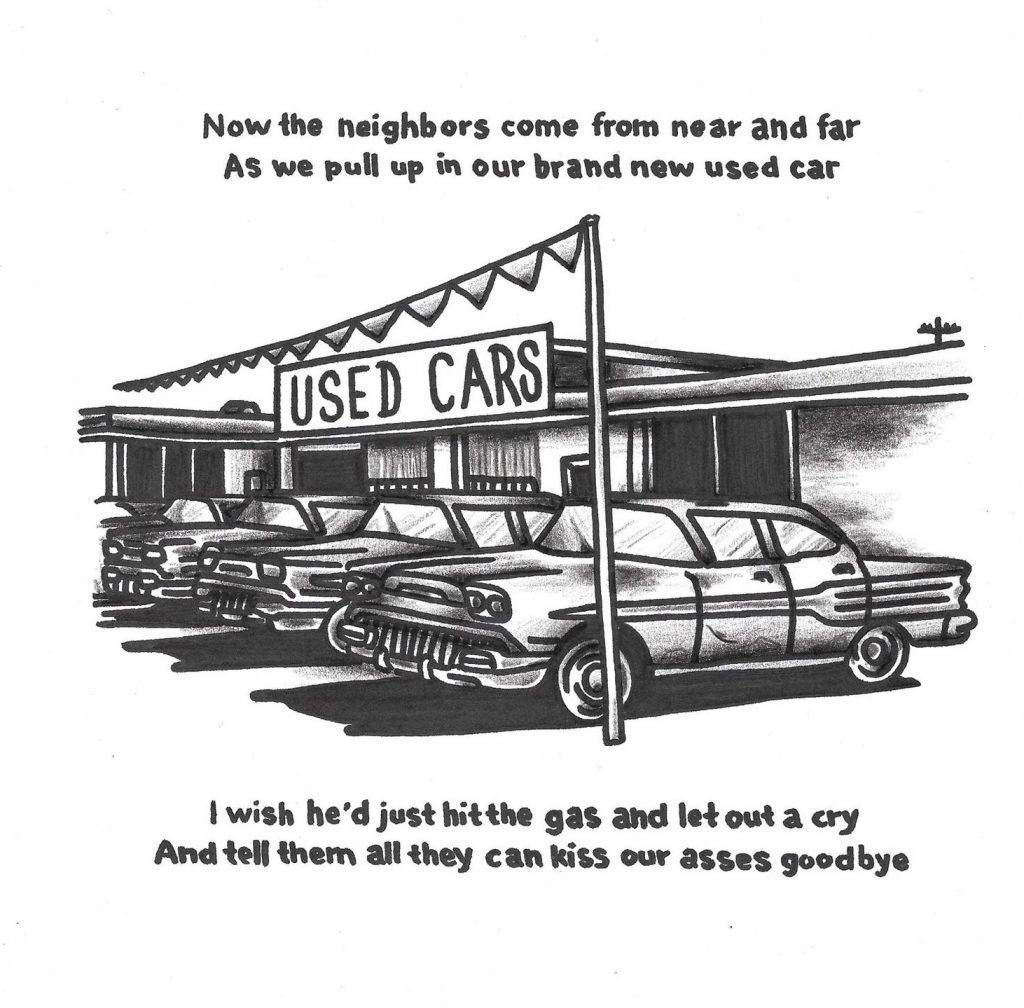
Born in the USA was written to be much more sparse, right? Originally the songs were stripped down versions, the title song was more bluesy and, of course, No Surrender is the most punk song in his catalogue…
We learned more from a three-minute record than we ever learned in school… So good!
But it’s lost in that full band bombast…
Even the song Born in the USA, when you ask a person on the street if they know the lyrics, most people are going to say, I was born in the USA and I was sent down to kill the yellow man… It sounds really redneck, like I’m proud to be an American and shoot Commies and all that sort of shit, but then you listen to it and it’s like, I lost my job at the plant, I came back and no one thinks I’m a hero, all my mates are dead, they didn’t come back, it’s the same narrative as Forrest Gump…
Born in the USA was co-opted by Ronald Reagan and the Conservatives as a rallying slogan and it has just never escaped that association. Although, since Springsteen came back with The Rising, and his role post as a sort of post-9/11 poet laureate figure, his politics have been made much clearer. His work has always fluctuated between big arena sounds and more intimate albums, like The Ghost of Tom Joad and Devils and Dust, but Nebraska definitely stands out…
Apparently, when they finally got into the record pressing stages of Born in the USA, he still had the tapes for Nebraska and every single time he got into a room with an engineer, he was like, we’ve got to put it out. I think they finally agreed to do a small run as a mini album, but it was recorded so poorly that every time they tried to cut it to a record, the lathe would bounce out of the record. They went through like five engineers or something to finally actually mix it properly because it was just like boombox recordings and the mics were too loud or there was not enough going on…
As a musician yourself, does the story behind the making of Nebraska, which Springsteen recorded on a four track in his bedroom, add to the allure of the album?
Yeah definitely. There’s so much information around and half of its fake, half of it is bullshit. The best story I’ve heard about it was that it was recorded on a Tascam four track, so to bounce it down to tape, you then record it on a boombox or a normal two track or stereo tape recorder. So, Springsteen bounced it down from a four track to a boombox and then he’d take that boom box out on a row boat and go fishing in an estuary. Apparently the boombox fell into the water and he waited for the tide to go out to get it back. The boombox was fucked but the tape was fine, so they washed out the tape and that’s why it’s got so much filth and grit to the music. It’s a great story, but I have no faith in it being real…
A real fishing tale…
Four tracks have a tape speed, so if you have a 40-minute tape, if you record on half speed, you get like 80 minutes. A lot of people think that Springsteen had the tape speed like just slower, but then whoever mixed it down for him, knocked it back to 12 o’clock, so if you try and play guitar to the songs, they are like a quarter step out of tune, and not in E or E flat, but like halfway between, which gives it this weird quality. I think people subconsciously resonate with it because it’s not an E chord or an E Flat chord like most bands would write music in, it’s something slightly different…
So, you play his songs?
Originally, I thought it would be cool to put on the show and have a different musician play each song from the album. I’ve got Johnny 99 and Reason to Believe down, but the rest of them are so hard to play. I don’t know if it’s because he recorded the guitars and then did vocals over the top, or it’s just his style, but there are some sentences I just can’t get through being able to strum it right, especially Reason to Believe and the bit about the preacher standing with the Bible and the congregation’s gone home, it bounces up and down differently to the way you strum a guitar. It’s probably just his style, but every time I get to that mark of the song, I fuck it up, it’s so hard…
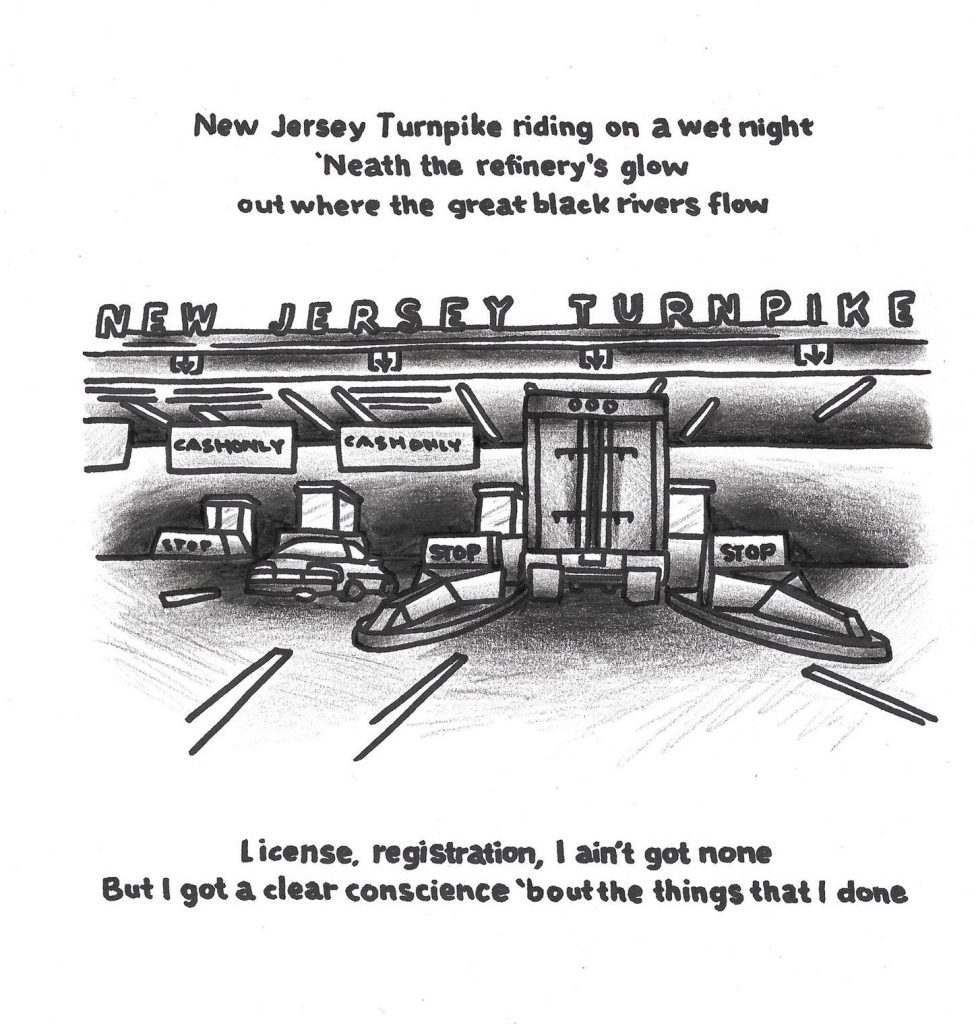
So, the exhibition is based on your response to each song?
Kind of, I’ve basically just drawn the image each song painted in my head. When I drew them, I wasn’t tattooing yet, I was still building, but I would draw after work three nights a week and I eventually just ran out of ideas. I had listened to the album a couple times and it hadn’t really resonated yet, but I valued Dan’s taste in music so much that I was like, it has to be good if he recommended it. I ended up working on a job by myself and instead of using a work radio I just wore headphones and I listened to the album. I used to always skip Nebraska [the first song and title track] because Atlantic City is such a banger, but I finally listened to Nebraska with headphones and the lyrics were clearer and the song is just about a guy and his girl killing ten people and getting the chair. I just thought it would be pretty cool to draw a guy sitting on an electric chair with his girl sitting on his lap. I was drawing so much after work and I just needed more briefs, so I was like oh, I’ll try to Atlantic City next week and then after I’d done three songs, I was like, well I have to do the whole record now and then they just sat for ages…
It became a ritual…
Every week, yeah. Instead of listening to the album, I would just listen to the one song I had to do that week, all week, to really try and close my eyes and think what the snapshot would be.
What was that process? Did you find yourself gravitating towards types of imagery or certain phrases?
Yeah, certain phrases…
Was there a consistency across the phrasing that you were picking out of each song? It seems to me a pretty cohesive album…
I think probably being a New Zealander and listening to songs written by a Jersey boy recorded on tape or whatever, lots of things in my head kind of had that Sopranos or old American movie type stuff. For Mansion on the Hill, I just had this big American, gothic-like Addams Family mansion…
There is some really memorable imagery throughout the album, like in Atlantic City: “Well, they blew up the Chicken Man in Philly last night…”
So good. There’s a really good newspaper photo of the Chicken Man’s house, his front door is like Ground Zero, like there’s just weather boards everywhere. Originally, I thought the Chicken Man was a go-to fried chicken spot and they blew it up because it had been abandoned or fallen apart, like the Santa Monica pier where the Z Boys surfed, which had fallen into such disrepair the Fire Department never showed up. I was like oh, the Chicken Man must be a restaurant, and then I read about the crime families and stuff, and it’s actually a guy…
Were you doing research to inform the imagery as well, or were you wanting a more pure response to the lyrics?
I think with the tattoo style and so much being reference based, I was trying to find actual references to draw on and still trying to capture the imagery from the song. The drawing I did for Johnny 99, I found a shot from a hostage scene in a movie, but then I had to draw one of them as Johnny 99, and one of them is a gas station attendant, so I had to research clothing a gas station attendant would have worn in America in the 50s or whatever, and try and make it look a little bit old school. So that was fun, having the image in your head and trying to draw it and portray it as more than a feeling because at the end of the day, it isn’t actually an image, it’s just an overall vibe that you’ve got in your mind…
Did you revisit any over time?
They were drawn and that was it. I think too, because the idea was to do one a week, and because I’m always trying to find shortcuts, one of the songs I didn’t initially rate that much, like My Father’s House, I would have been quite happy to skip it and just do it at the end, but I just knew if I did all of them and left that one until the end, I would have just skipped it and never done it. As a result, having to listen to My Father’s House for a whole week, by the end, I was like, this is such a great song…
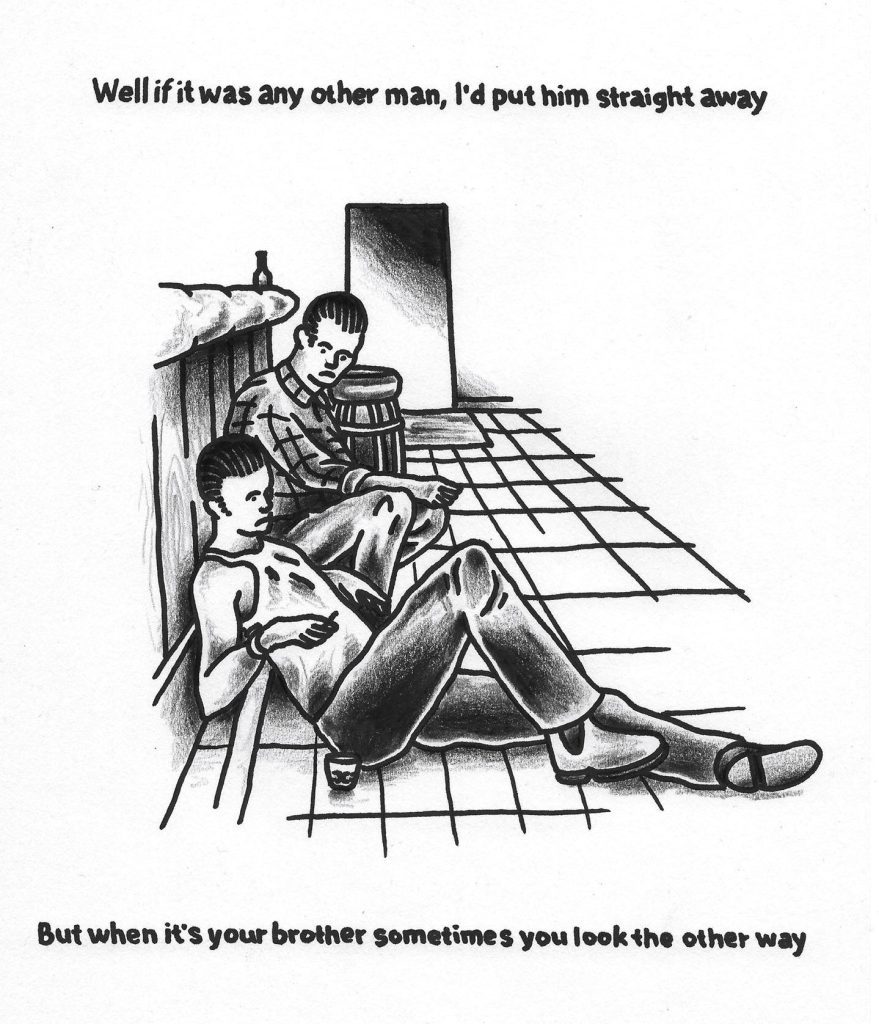
So, when you were originally drawing them, were you drawing them as tattoo flash?
Yeah, the expectation was just that people would get them tattooed. People responded to them really well, but no one actually got them tattooed. I drew them ages ago, so I thought I will see what happens, if I tattoo them or not. But then a couple of years ago I was like, I need to do a zine and an exhibition. The space at the shop [Absolution] was already booked out for like a year, but I saw that the 40th anniversary of the album was coming up in two years’ time so, I thought, two years is ages away but it would work. It flew by because of Covid, so I was like oh shit, two years already! Time to do the show…
It feels like a traditional tattoo style is a really good fit with the album. I know the most immediate association is the black and white album cover image, but if you were to turn Nebraska into an art style, I kind of think it would be black and white photography and traditional tattoo flash…
At the time, my main medium was a Sharpie pen and black colouring pencil. It still is now, but instead of using a Sharpie I use a point 6 Artliner, so it’s just a little bit smaller. But the thing I love about a Sharpie, especially for text, is that if you make the text too small, things like a lowercase E, get the bleed in the eye of the E and it becomes solid, it’s the same as if you were using a typewriter and the ink was too runny, all those things close up. In traditional tattooing, because the lines are so bold, if you do them too small the lines go close together, so all the designs have to be very contrasting to the skin that you don’t tattoo, so all the lines have to be far apart. So, for instance, if you are tattooing a hand, you don’t bother doing all four fingers because you know it will just blow out and become black, so you imply the form. On Nebraska because a lot of the songs are demos, a lot of the details are implied; the harmonica solos, and you know when he does those high pitch screams, I feel like a lot of those are his way of saying this is where the sax solo would go… Because it’s just a tape recording, there’s no thought put into it. I will play four bars, and I will whistle, or I’ll play harmonica, and in the studio we can decide whether it’s going to be sax or synth. That’s kind of the beauty, because its good enough. People will be led to believe it’s a conscious decision and it’s the same with tattooing with a really big needle, you are kind of governed by how much freedom you have, so the decision you make is that less is more, I guess. You can sort of imply something in same the way you would imply a sax solo by just humming, and people will go I love how you are humming that bit and you go, I didn’t know what else to do…
When you look at the works now and when you think about displaying them, does it make you more aware of the album’s narrative?
I think what hammered that home was the introduction I wrote for the zine. I wrote it as a dedication to everyone who is described in the album; everyone who ever felt like going on a killing spree with their girlfriend, or wanted to live in the big mansion on the hill, or fell out with their parents and that sort of shit. The last song is Reason to Believe, so it comes around to a dedication to all these people who went through all this shit and somehow, even though you are at the end of your rope, there’s something to believe in that is bigger than we all are, and then the album just ends. So, there is that conscious story-telling that is so good, you can’t believe that the sequencing hasn’t had a heap of thought put into it, we’ll close it out with this song about faith, and he doesn’t even mention that it’s in God, he just mentions that there is something that makes you get out of bed each day…
That reason can be so many things; the person you wake up next to, the vision of that house you grew up in, everything that precedes that song can be one of those reasons to believe…
Like in Open All Night, I drew a nice car, but he talks about having this car up on blocks, working on it. It’s probably a shitter, but he loves it and that’s probably his reason to believe, this rad car…
Cars are such an important image in Springsteen’s songs…
Nebraska is about the first ever spree killer, the first person to kill in a car crossing state lines. In his autobiography, Springsteen talks about how his Nana or someone told him in an electrical storm you can’t get electrocuted in a car because of the rubber tyres, so in the book, he’s like, when I was a little kid whenever there was a lightning storm I would run out of the house right into the car, and then I proceeded to write songs about automobiles for the next 40 years of my life. His whole career comes back to this story of cars being like a saviour…
So, what do people need to know about the show?
It opens at Absolution on Friday the 30th of September, which is also the 40th anniversary of Nebraska, technically it would be Saturday, Friday in America, but yeah, it starts at 6pm. I’m thinking I might give away a prize for the best Springsteen outfit, but I’m going to try and encourage people to think outside the box and not dress like Born in the USA Springsteen, which I think is the whole point, educating people that there is a Springsteen behind the Boss. Like Dan said, forget everything you know about Springsteen, this is the record. If you don’t like Springsteen yet, hopefully this one is the one…
I’m not sure how I’m going to lay it out yet. It’s rare to not see a tattoo artist use an iPad now, even I use an iPad, but back in the day, you used to do everything on tracing paper first, then you would do a nice one on paper. I’ve still got the tracing paper drawings from these works, so I’m thinking, because Nebraska was a demo album, I might hang all the final artworks and then around the corner I might hang all the tracing paper works and the lino cuts and all that sort of stuff. I was thinking I might use a string line to line everything up but I might leave it up, highlighting that Nebraska was a working idea that wasn’t supposed to be finalised and left like that…
What’s the one line from Nebraska that you think best sums it up?
I probably change my mind every day when I listen to it, but right now it’s probably in Reason to Believe:
Take a baby to the river, Kyle William they called him
Wash the baby in the water, take away little Kyle’s sin
In a whitewash shotgun shack an old man passes away
Take his body to the graveyard and over him they pray
It all happens in the same breath of air, someone’s in, someone’s out. We are all just doing it. Reason to Believe is probably my favourite song on the album, as much as I love Atlantic City, but Reason to Believe is so good, there’s the line about the girl waiting for Johnny to come back, there’s the wedding, the preacher standing with the bible but the bride didn’t show and the congregation’s gone home. It’s a tough one, actually maybe it’s the opening line:
Seen a man standin’ over a dead dog lyin’ by a highway in a ditch
He’s lookin’ down kinda puzzled, pokin’ that dog with a stick
Got his car doors flung open he’s standin’ out on Highway thirty-one
Like if he stood there long enough that dog’d get up and run
It’s a vivid image, right?
It’s such a wicked lyric, like did he see that or just make it up? I like the idea of someone just standing there being like, c’mon, get up man, this can’t be it… It might come back to the death of the American dream, poking it with a stick is not going to get it going again, you just have to get back in your car and keep driving.
But it’s the reason to believe, it might not get up and run, but you can hold onto something, hope is always there…
Or you could be the dog, hoping someone might poke you and not just keep speeding past…
Tom Kerr’s Nebraska opens at Absolution Tattoo and Body Piercing, 6pm, Friday 30th September, 2022.
Follow Tom on Instagram…

